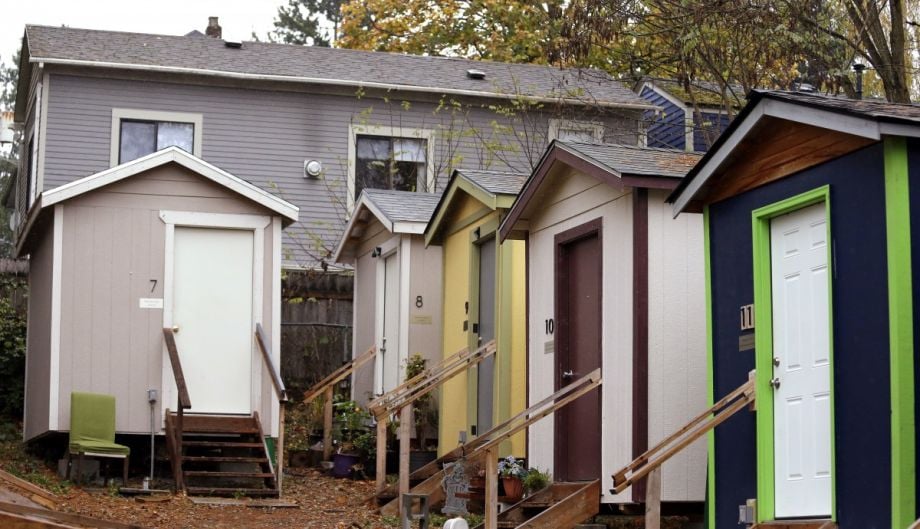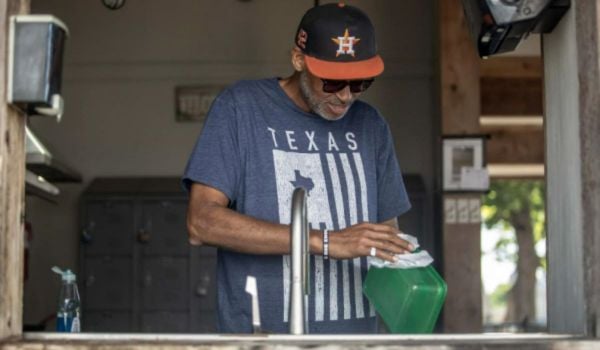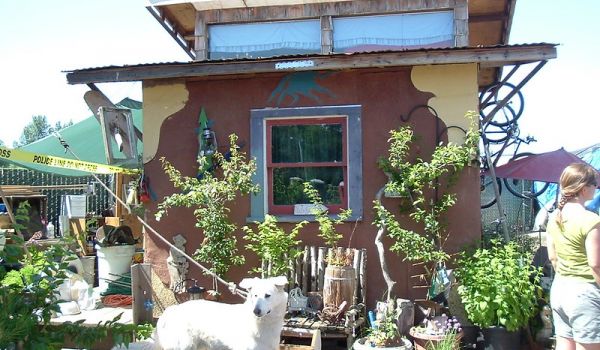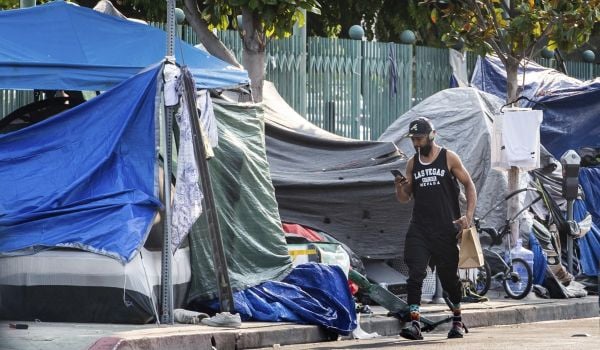Allison Artzer has been homeless for over three years, much of which she spent on the streets of San Francisco. Ten months ago, while sitting on a curb with all her belongings, the 36-year-old was approached by a member of San Francisco’s Homeless Outreach Team and offered a tent in one of the city’s “safe sleeping villages” on 33 Gough Street, off Market Street.
Artzer, who had her belongings stolen many times or thrown out by police officers while on the streets, said yes.
She found it was a big improvement from the street, allowing her a central place to keep her belongings and a space to call her own. But the tent has some drawbacks. When it rains, her belongings get wet and some are destroyed, regardless of how many tarps she throws over it. At night, the temperature can dip close to 45 degrees, and she must huddle under blankets to fight the cold. She shares a tent with her partner, and because the tents are so thin, they’re unable to have private conversations.
This is why she was excited when she heard the city would be replacing her tent with a small cabin, with a door that locks, a bed, a desk and a space heater.
“My life has changed for the better for the past 10 months, just having a place to call home, even though it’s a tent,” she says. “Now I’m wanting to start looking to have a job again and be a normal person again.”
San Francisco officials announced in September that they would be building a tiny home village on Gough Street, where it currently facilitates a cluster of tents with on-site security. The 44 tents will be replaced with about 70 tiny homes, each about 64 square feet, across two parking lots the city is leasing.
The homes are part of a pilot project that will last 18 months, at which point the city’s lease on the parking lot on Gough Street will lapse. The project is coordinated by the city, but funded by DignityMoves — part of an umbrella organization that bundles private capital toward social issues — as well as a nonprofit funder called Tipping Point. Urban Alchemy, another nonprofit, is already providing social services to the tent community and will continue those services for the tiny homes. (Urban Alchemy also provides services to two other safe sleeping villages in San Francisco.)
The project is one of several announced this year as San Francisco Mayor London Breed added more than $1 billion over two years to the Department of Homelessness and Supportive Housing, an investment that includes an RV park.
Elizabeth Funk, CEO of Dignity Capital, which assembled the group “DignityMoves” that will be funding the site, says the city had until recently spent relatively little on transitional housing. The tents and the tiny home model are meant to provide a more hospitable alternative to street homelessness, affording privacy and safety that aren’t available in dormitory-style shelters.
“We really believe that having people have their own private space is going to be a game-changer,” Funk says.
The sites are also meant to help people transition into a more stable mental state after experiencing the trauma of living on the street.
“I can tell you first hand that everybody experiences trauma while homeless,” says Andrea Urton, CEO of HomeFirst Services of Santa Clara County, who says she is formerly homeless.
“They’re in a heightened state of panic and crisis,” she says. “Your health deteriorates, your mental ability to problem solve deteriorates over time.” Urton says it takes three to six months of stable housing for people to get their head cleared.
HomeFirst will be a consultant for San Francisco’s tiny home project, bringing their experience setting up San Jose’s first tiny home community. Among the lessons learned there, Urton says, are that having staff on hand to help with rapid rehousing is crucial.
While Funk, with Dignity Capital, is unsure how long stays will be, they are modeling their approach on Life Moves, which built a tiny house community in Mountain View using money from Project Homekey, a statewide program meant to convert unused space into housing. Stays in the Mountain View site averaged between 90 to 100 days. That site also has on-site mental health care, nurses and social workers, which the Gough Street site will not.
The expectation of rapid rehousing for San Francisco’s tiny home community may be related to the desires of its funders. DignityMoves is a coalition of business-owners across the bay area who wanted to solve the problem of street homelessness. Funk acknowledges that some business-owners have “selfish reasons” for wanting to help, likely out of fear that street homelessness has decreased spending at commercial corridors.
Urton says that if the San Francisco site wants to rehouse people quickly, having staff on hand to handle housing issues is crucial. “Unless there are rapid rehousing services attached to the units, it takes a lot of time to permanently rehouse people,” she says.
But Lena Miller, who runs Urban Alchemy, says it may not be realistic to expect quick rehousing of the residents at the Gough Street site because there aren’t enough permanent housing units to rehouse people quickly. She also believes that many residents have underlying issues like mental health and substance abuse problems that need to be addressed.
Artzer says her attempts to find housing while in the sleeping village on Gough Street have been fruitless. She was interviewed twice for housing but did not qualify. She says the housing offered was being prioritized for people with mental health issues or with physical disabilities, which she doesn’t have. “My only problem is that I’m homeless,” she says. In the 10 months she’s been in the sleeping village, she says only 6 people that she knew got placed into permanent housing.
Urban Alchemy has two “care coordinators” on staff at the Gough Street site each day who connect residents to outside agencies if they need social workers, as well as another 5-6 people who work throughout the day resolving conflicts and helping with everyday tasks. Miller says the nonprofit will likely hire another care coordinator once the tiny homes are built, as they will be receiving more funding to handle the addition of two dozen people to the population.
San Francisco officials claim that the tiny home project will have a cheaper per-person cost than maintaining 44 tents across the lot. The majority of the cost for the tent village is from security and other personnel costs, as the tents themselves cost a little over a hundred dollars each. The city calculates that by increasing the density of people who can live on the space with tiny homes, which will be spaced closer together than the tents, they will be reducing per-person costs even as they are spending more money.
It’s unclear if this prediction will prove true. Urton of HomeFirst says one of the lessons from the San Jose project was that costs went higher than anticipated.
“We budgeted much lower for electricity than we planned,” she says. “It’s way more expensive than we thought.” She also pointed to a need for licensed therapists, social workers and drug treatment in tiny home communities to help people transition back into society.
But Miller of Urban Alchemy says it’s unlikely that either the city or private funders would want to take up that cost at the Gough Street site, even with the city’s $1.2 billion homelessness budget.
“There’s probably more than can be done,” she says, “you need therapists, drug treatment, it’s extremely high need.” While most people experience homelessness due to economic hardship or a lack of housing, Miller says residents of San Francisco’s safe sleep villages have higher than average populations experiencing addiction and mental illness.
“An extremely high percentage of folks who are living in the village are dual diagnosis,” she says. “If you add up addiction services, what people really need to recover and thrive, the price tag is going to be astronomical.”
For Artzer, who says she doesn’t suffer from addiction or mental illness and describes herself as healthy, having a secure tent in the sleeping village has been an immeasurable help. She first became homeless three years ago while working as a waitress. When a series of housing situations went awry, she lost her security deposits and couldn’t afford a new place. She ended up renting hotels on a nightly basis, but the distance from work led her to miss shifts and she eventually lost her job. With no income, she was soon on the street.
“It just happened so quickly, being a normal person inside working, to being outside, it was scary,” she says. “You get used to it I guess.”
This article is part of Backyard, a newsletter exploring scalable solutions to make housing fairer, more affordable and more environmentally sustainable. Subscribe to our weekly Backyard newsletter.

Roshan Abraham is Next City's housing correspondent and a former Equitable Cities fellow. He is based in Queens. Follow him on Twitter at @roshantone.


















